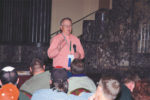Advertise Follow Us
Articles Tagged with ''Radiographs''
The causes of this common problem may be more complex than they appear on the surface
Read More
One Veterinarian's Viewpoint
Why Heart Bars Can Work Well With Laminitis
Forget the bute and other chemical pain relievers when it comes to treating laminitis cases, advises this equine veterinarian
Read More
Book Notes
Overcoming Founder Step by Step
Founder Data Collection And Analysis — How to Take, Read and Interpret Radiographs for the Prognosis and Treatment of the Foundered Horse
Read More
Dealing with Quarter Cracks and Sheared Heels
Double-trim method found effective in removing cause of the problem
Read More
Breeding Better Feet
When it comes to foot conformation, there are more questions than answers
Read More
Adding A Farrier Day To An Equine Veterinary Practice
A well-planned program promotes hoof-care knowledge, improves farrier-veterinarian communication and pays off for everyone
Read More







